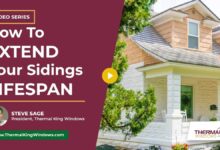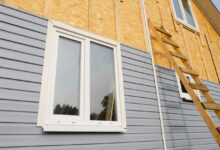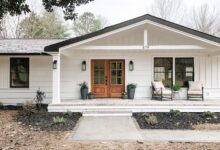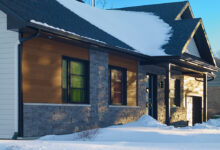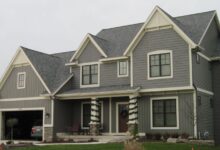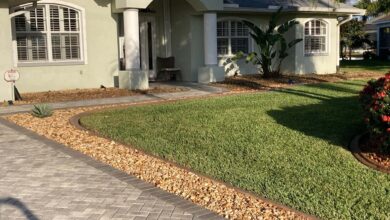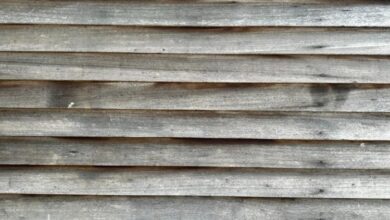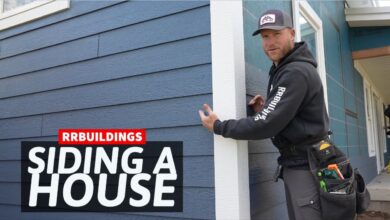Trendy Siding Textures for Modern Homes
Trendy Siding Textures for Modern Homes: The exterior of your home makes a statement. Choosing the right siding not only protects your investment but also significantly impacts your home’s overall aesthetic. This exploration delves into the current trends in siding textures for modern homes, examining popular materials, impactful color combinations, and the interplay of light and shadow to create stunning visual effects. We’ll cover everything from the practical considerations of maintenance and sustainability to the psychological impact of texture and color choices, ultimately guiding you towards creating a truly modern and captivating façade.
From sleek, minimalist designs to more textured, expressive styles, the options are vast. Understanding the nuances of different materials—like wood, fiber cement, vinyl, and stucco—and their respective texture capabilities is crucial. We’ll explore how texture can subtly alter the perceived size and shape of your home, and how careful consideration of light and shadow can dramatically enhance the final result. This guide provides a comprehensive overview, empowering you to make informed decisions about your home’s exterior.
Defining “Modern” in Home Siding
Defining “modern” in the context of home siding requires understanding the broader architectural movement and its key aesthetic principles. It’s not simply a matter of current trends; rather, it reflects a consistent set of design philosophies that have evolved over time. Modern aesthetics emphasize clean lines, functionality, and a connection between the building and its environment.
Modern home siding, therefore, reflects these principles through the choice of materials, colors, and textures. The texture itself plays a crucial role in conveying the desired modern aesthetic, contributing to the overall impression of simplicity, sophistication, and a contemporary feel.
Architectural Styles Considered Modern
Several architectural styles embody the principles of modern design. These styles share a common thread of prioritizing functionality and clean lines over ornamentation. Examples include International Style, Mid-Century Modern, and contemporary architecture. International Style, for instance, is characterized by its stark geometric forms, flat roofs, and the use of industrial materials. Mid-Century Modern often incorporates organic shapes and natural materials while maintaining a streamlined aesthetic. Contemporary architecture builds upon these traditions, often experimenting with innovative materials and sustainable design principles. These styles are not mutually exclusive; contemporary architecture often draws inspiration from both International Style and Mid-Century Modern.
Characteristics Defining Modern Home Aesthetics
Modern home aesthetics are characterized by several key features. Simplicity and minimalism are central tenets, prioritizing clean lines and uncluttered spaces. A focus on functionality ensures that design elements serve a practical purpose. The use of natural light is often maximized through large windows and open floor plans. Neutral color palettes are frequently employed, creating a sense of calm and spaciousness. Materials are selected for their inherent qualities and durability, often featuring a natural or industrial aesthetic. Finally, a strong connection between the interior and exterior spaces is often a key design element.
Siding Texture’s Contribution to a Modern Look
The texture of siding significantly impacts the overall aesthetic of a modern home. Smooth, flat siding surfaces, such as those found in fiber cement or certain types of vinyl, create a clean, minimalist look that is synonymous with modern design. Conversely, textured siding, such as wood-look planks with subtle variations or sleek metal panels with a brushed finish, can add depth and visual interest while maintaining a contemporary feel. The key is balance – avoiding overly ornate or busy textures that detract from the clean lines and simplicity that define modern architecture. The right texture can subtly enhance the home’s architectural features, creating a sophisticated and refined appearance. For example, a smooth, light-colored fiber cement siding can accentuate the sharp angles of a modern home, while a subtly textured metal panel can add a touch of industrial chic.
Popular Siding Materials
Choosing the right siding material significantly impacts a modern home’s aesthetic appeal, durability, and maintenance requirements. The texture of the siding plays a crucial role in achieving the desired architectural style, from sleek minimalism to a more rustic feel. Several materials offer a wide range of textural possibilities, each with its own set of pros and cons.
Popular siding materials offer diverse textural options, influencing a home’s overall aesthetic. Understanding these differences is crucial for informed decision-making during the design and construction phases. The following sections will explore five common materials, comparing their textural capabilities and cost implications.
Five Common Siding Materials and Their Textures
Five common siding materials frequently used in modern home construction are fiber cement, vinyl, wood, metal, and engineered wood. Each material provides unique textural possibilities, influencing the final look and feel of the home’s exterior.
| Material | Texture Options | Cost Considerations |
|---|---|---|
| Fiber Cement | Smooth, wood grain, stucco, rough-hewn | Medium to High. Durable and long-lasting, but initial investment is higher than vinyl. |
| Vinyl | Smooth, wood grain, textured (e.g., clapboard, shingle) | Low to Medium. Affordable and easy to maintain, but may not be as durable as other options. |
| Wood | Smooth, rough-sawn, shiplap, board and batten | Medium to High. Offers natural beauty and varied textures but requires regular maintenance and is susceptible to weather damage. |
| Metal | Smooth, corrugated, ribbed, patterned | Medium to High. Highly durable and low-maintenance, but can be more expensive upfront and may be susceptible to dents. |
| Engineered Wood | Smooth, wood grain, textured | Medium. Combines the aesthetic appeal of wood with improved durability and resistance to moisture compared to traditional wood. |
Texture Trends in Modern Siding
Modern home design increasingly emphasizes the interplay of form and texture, extending this focus to exterior siding. The right siding texture can dramatically enhance a home’s curb appeal, adding depth, visual interest, and a distinct personality. This section will explore three prominent texture trends shaping contemporary home exteriors.
Smooth and Sleek Textures
Smooth siding conveys a sense of sophistication and minimalism, aligning perfectly with the clean lines often found in modern architectural styles. This texture is particularly effective in creating a visually uncluttered façade, allowing other architectural details to stand out. Smooth textures are achievable with a variety of materials. Fiber cement siding, for example, can be finished to a very smooth surface, offering a contemporary look with excellent durability. Certain types of vinyl siding also offer smooth finishes, often mimicking the appearance of stucco or painted wood. The visual impact is one of understated elegance; the clean lines and lack of overt texture create a sense of calm and refined simplicity. A home sided with smooth materials appears modern, streamlined, and potentially even futuristic depending on the overall design.
Wood-Like Textures
Despite the popularity of alternative materials, the warmth and natural beauty of wood remain highly desirable. Many modern homes incorporate wood-like textures in their siding, often achieved through engineered wood products or high-quality vinyl and fiber cement imitations. These materials offer the aesthetic appeal of real wood without the associated maintenance challenges. For instance, engineered wood siding, like those made from composite materials, replicates the grain and texture of various wood species, providing a natural look with enhanced durability and resistance to weather damage. Similarly, advanced vinyl siding manufacturing techniques now allow for highly realistic wood grain replication, achieving a visually convincing texture that is both low-maintenance and cost-effective. The visual impact is one of inviting warmth and natural charm, successfully balancing the modern aesthetic with a touch of organic appeal.
Rough and Textured Surfaces
In contrast to smooth finishes, rough and textured siding offers a bold, tactile appeal. This trend leans towards a more rustic or industrial aesthetic, adding depth and visual complexity to the home’s exterior. Materials like stucco, especially when applied with a varied texture, can create a visually interesting surface. Certain types of fiber cement siding also come in finishes that mimic natural stone or rough-hewn wood, providing a substantial, textured appearance. The visual impact is one of strength and character; the varied surface creates shadows and highlights, adding dimension and a sense of substantial presence to the home. This texture can lend a feeling of groundedness and permanence, particularly effective in homes with a more grounded, less sleek design.
Color and Texture Combinations
The interplay of color and texture in modern siding is crucial for achieving a visually appealing and cohesive home exterior. Careful consideration of these elements can significantly impact the overall aesthetic, influencing the perceived size, style, and even the mood of the house. The right combination can elevate a home’s curb appeal, while a poor choice can detract from its architectural features.
Effective color and texture pairings often rely on creating a balance – contrasting elements to add visual interest, while maintaining harmony to avoid a jarring effect. For example, a smooth surface might pair well with a bold color to create a striking modern look, whereas a textured surface might benefit from a more subdued palette to allow the texture itself to be the focal point. Psychological effects, such as the calming influence of certain colors or the stimulating effect of specific textures, also play a vital role in the selection process.
Examples of Effective Color and Texture Combinations
Several effective color and texture combinations are widely used in modern home siding design. These pairings leverage the principles of contrast and harmony to create visually pleasing and aesthetically coherent exteriors. Consider the following examples, which showcase diverse approaches to achieving a modern aesthetic.
| Color | Texture | Overall Aesthetic | Example |
|---|---|---|---|
| Deep Charcoal Gray | Smooth, Linear Wood Grain | Sophisticated, Sleek | Imagine a modern farmhouse with clean lines, accented by black window frames. |
| Warm Beige | Rough-hewn Stucco | Rustic, Earthy | A Mediterranean-style home with textured stucco walls, complemented by terracotta-colored accents. |
| Cool, Light Gray | Smooth Fiber Cement | Minimalist, Clean | A contemporary home with a flat, uncluttered facade, emphasizing clean lines and simplicity. |
| Muted Green | Vertical Shiplap | Tranquil, Natural | A home with a relaxed, natural feel, incorporating vertical shiplap siding in a soft, calming green shade. |
Psychological Effects of Color and Texture Combinations
Color psychology significantly influences the perception of a home’s exterior. Warm colors like reds and oranges create a welcoming and energetic feel, while cool colors such as blues and greens evoke calmness and serenity. Similarly, textures impact the mood. Rough textures can feel rustic and inviting, while smooth textures often project a sense of sophistication and modernity. The combination of these elements shapes the overall atmosphere and emotional response elicited by the home’s exterior. For instance, a home with smooth, gray siding might feel more formal and modern, while a home with rough, textured wood siding in a warm brown might feel more comfortable and inviting. The strategic use of color and texture allows architects and homeowners to create a specific emotional response from viewers.
Impact of Light and Shadow on Texture
The interplay of light and shadow is crucial in how we perceive and appreciate the texture of any surface, including home siding. The way light interacts with the surface irregularities profoundly influences the overall visual impact, transforming a simple material into a dynamic and engaging façade. Understanding this interplay allows homeowners and designers to strategically utilize light and shadow to enhance the aesthetic appeal of their modern homes.
Light and shadow dramatically affect the perception of siding textures by creating depth, highlighting details, and influencing the perceived color. Direct sunlight accentuates raised textures, casting shadows that emphasize the three-dimensionality of the material. Conversely, soft, diffused light tends to soften the appearance of texture, creating a more uniform and less dramatic effect. The angle of the sun throughout the day, as well as the overall ambient light, will significantly alter the perceived texture. A deeply textured siding might appear almost smooth in low light conditions, while the same siding could exhibit dramatic depth and shadow in bright sunlight.
Effects of Different Light Sources
Different light sources produce varied effects on siding textures. Direct sunlight, especially during midday, creates strong, defined shadows that emphasize the texture’s depth and contours. This is particularly effective with materials featuring pronounced grooves, vertical lines, or intricate patterns. Conversely, overcast skies provide softer, more diffused light, minimizing shadows and creating a smoother, less textured appearance. Artificial lighting at night can also impact perception; warm, yellowish light might soften textures, while cooler, bluish light could enhance contrast and highlight irregularities. The type of lighting, its intensity, and its direction are all factors to consider when designing a home’s exterior.
Using Light and Shadow to Enhance Visual Appeal
Strategic placement of windows, overhangs, and landscaping can be used to manipulate the interplay of light and shadow on siding. For example, a deep overhang can create dramatic shadows on a textured siding during the day, enhancing its three-dimensionality. Similarly, strategically placed trees or shrubs can cast dappled shadows that add visual interest and soften the appearance of the siding. Conversely, open areas with minimal shade will allow for maximum light exposure, showcasing the full impact of the siding’s texture. Consider the orientation of the house in relation to the sun’s path to optimize the use of natural light and shadow throughout the day.
Examples of Siding Designs Maximizing Light and Shadow
A home with vertical wood siding, installed with varying widths of boards, will exhibit a dynamic play of light and shadow, particularly in the late afternoon sun. The shadows created between the boards will accentuate their individual forms and add visual depth to the overall design. Similarly, a home with a horizontally installed, deeply textured stone veneer will create dramatic horizontal lines of shadow, adding a sense of solidity and strength. Modern homes often incorporate large windows that allow natural light to wash across the siding, interacting with its texture to create a visually interesting interplay. The contrast between light and shadow on a textured surface can also be amplified through the use of contrasting colors, further enhancing the visual impact. A dark gray siding, for instance, will show a stronger contrast between light and shadow compared to a light beige siding.
Siding Texture and Home Size/Shape
The texture of your home’s siding can subtly, yet powerfully, influence how its size and shape are perceived. Clever use of texture can create the illusion of a larger or smaller space, a taller or shorter structure, or even alter the perceived proportions of the building. Understanding the principles of visual perception is key to leveraging this effect for a more aesthetically pleasing and potentially even more valuable property.
Siding texture manipulates our visual perception through the interplay of light and shadow. Rough textures tend to visually break up large surfaces, making them appear smaller and less imposing. Conversely, smooth textures create a more unified visual field, potentially making a smaller home appear larger and more expansive. The direction of the texture’s lines also plays a crucial role; vertical lines tend to elongate a structure, making it seem taller and narrower, while horizontal lines can broaden the perceived width, making it appear shorter and wider.
Visual Perception and Siding Texture
The human eye interprets visual information based on several factors, including contrast, scale, and pattern. Rough textures, with their inherent variations in depth and light reflection, create visual interest and break up large expanses of wall space. This fragmentation reduces the sense of overwhelming scale. For example, a large, ranch-style home clad in rough-hewn wood siding might appear more inviting and less monolithic than the same house with smooth stucco. In contrast, smooth textures create a sense of continuity and uniformity, which can make a smaller house feel more open and spacious. A small cottage with smooth, painted lap siding will appear larger than if it were clad in a heavily textured stone.
Examples of Siding Texture and House Shape Modification
Consider a narrow, two-story townhouse. Using vertical lines in the siding, such as vertical shiplap or narrow, vertically-oriented planks, would visually emphasize the height, making the building appear taller and slimmer, thus mitigating the feeling of narrowness. Conversely, a wide, low-slung ranch house might benefit from horizontal siding, such as wide planks or horizontal lap siding, which would emphasize the width and create a more grounded appearance. A house with a complex, asymmetrical shape could use a textured stone veneer to add visual interest and break up the different planes of the facade, preventing it from appearing too fragmented or disjointed. Conversely, smooth stucco could unify the facade of such a home and give it a more cohesive appearance.
Texture and the Illusion of Depth
Textured siding can also be used to create the illusion of depth. For instance, a recessed entryway could be accentuated by using a darker, more textured siding material that contrasts with the lighter, smoother siding on the main facade. This contrast creates a visual recession, making the entryway appear more defined and inviting. Conversely, using a lighter, smoother material on a protruding bay window could make it seem to advance further from the facade. The play of light and shadow across the different textures will emphasize this effect.
Maintenance Considerations for Different Textures
Choosing the right siding not only enhances your home’s aesthetic appeal but also significantly impacts its long-term maintenance needs. Different textures present varying challenges and benefits regarding durability and upkeep. Understanding these differences is crucial for making an informed decision that aligns with your lifestyle and budget. This section details the maintenance requirements for popular siding textures.
Maintenance Requirements of Various Siding Textures
The longevity and ease of maintenance for your home’s exterior depend heavily on the chosen siding material and its texture. Some textures are more resistant to damage and easier to clean, while others require more frequent attention. This comparison highlights the pros and cons of various options.
- Smooth Siding: Smooth siding, such as certain types of vinyl or fiber cement, is generally easy to clean. Dirt and debris are easily removed with a simple hose-down. However, minor scratches and dents may be more visible on smooth surfaces than on textured ones. Its ease of cleaning is a significant advantage, minimizing maintenance time and effort. The potential for noticeable scratches is a disadvantage that should be weighed against this ease of maintenance.
- Wood Siding (with varying textures): Wood siding offers a wide range of textures, from smooth clapboard to deeply textured shiplap. Maintenance varies greatly depending on the type of wood and finish. Regular sealing and staining are essential to protect against moisture damage and decay. Cleaning often involves more careful attention to avoid damaging the wood’s finish. While offering a classic and visually appealing texture, wood requires consistent maintenance to preserve its beauty and longevity. Neglecting maintenance can lead to significant repair costs.
- Stucco: Stucco, known for its rough texture, is relatively durable and resistant to damage. However, it can be prone to cracking over time, especially in areas with significant temperature fluctuations. Regular inspection for cracks and prompt repair are crucial to prevent further damage. Cleaning typically involves pressure washing, but care must be taken to avoid damaging the surface. Stucco’s durability is a plus, but its susceptibility to cracking necessitates vigilant monitoring and occasional repairs.
- Brick Siding: Brick offers exceptional durability and requires minimal maintenance. Cleaning usually involves occasional power washing to remove dirt and grime. However, mortar can crack or deteriorate over time, requiring repair. While largely low-maintenance, the need for occasional mortar repairs is a factor to consider. The long lifespan and robust nature of brick are key benefits.
- Fiber Cement Siding (with varying textures): Fiber cement siding is available in a variety of textures, mimicking wood or stone. It’s durable and relatively low-maintenance, typically requiring only occasional cleaning with a hose or pressure washer. However, it can be more susceptible to staining than some other materials. Its durability and low maintenance are attractive features, but its potential for staining requires consideration.
Sustainability and Eco-Friendly Options
Choosing sustainable siding not only reduces your environmental footprint but also contributes to a healthier living environment. The production, transportation, and disposal of siding materials all have environmental consequences, making responsible material selection crucial for modern homeowners. This section explores eco-friendly options and their impact.
Sustainable siding materials prioritize renewable resources, reduced energy consumption during manufacturing, and minimal environmental impact throughout their lifecycle. They aim to minimize pollution, conserve resources, and promote responsible waste management. The choice of siding can significantly affect a home’s overall energy efficiency, contributing to lower utility bills and a smaller carbon footprint.
Recycled and Reclaimed Materials
Using recycled and reclaimed materials offers a significant advantage in reducing landfill waste and the demand for newly extracted resources. Reclaimed wood siding, for instance, provides a unique aesthetic while offering a substantial reduction in embodied carbon compared to newly harvested wood. Similarly, siding made from recycled plastic or other post-consumer materials offers a sustainable alternative to virgin materials, reducing the environmental burden associated with resource extraction and processing.
Fiber Cement Siding Composition and Environmental Impact
Fiber cement siding, a popular choice for its durability and versatility, offers a relatively low environmental impact compared to some other options. While its production does involve cement manufacturing, which has a carbon footprint, the use of recycled materials in the mix and the long lifespan of the product can offset some of these effects. The overall environmental impact depends heavily on the specific manufacturing processes and the proportion of recycled content used. For example, a fiber cement siding product with a higher percentage of recycled fly ash would have a lower carbon footprint than one with a lower percentage.
Innovative Sustainable Siding Solutions
The building industry is constantly innovating to create more sustainable siding options. One example is the development of bio-based materials, such as siding made from rapidly renewable plant fibers like bamboo or hemp. These materials offer a low-carbon alternative to traditional materials and can often be locally sourced, further reducing transportation emissions. Another area of innovation involves the development of siding materials with improved energy efficiency properties, such as those incorporating insulation or reflective coatings to reduce energy consumption for heating and cooling.
Illustrating Texture through Description
Understanding the tactile and visual qualities of siding materials is crucial for selecting the right aesthetic and maintaining a home’s exterior. Different textures evoke distinct feelings and contribute significantly to the overall architectural impression. The following descriptions aim to provide a clear picture of three common siding textures.
Rough-Hewn Wood Siding
Rough-hewn wood siding presents a distinctly rustic appearance. The surface is uneven, with visible knots, grain variations, and tool marks from the initial shaping process. These imperfections contribute to its character. Visually, the surface appears deeply textured, with shadows accentuating the irregularities and creating a sense of depth. Tactilely, the surface is uneven and slightly rough, offering a tangible sense of the wood’s natural state. The texture might range from subtly textured to deeply furrowed depending on the specific hewing technique and the type of wood used. Running your hand across it might reveal splinters or slightly raised areas. This texture evokes a feeling of naturalness and warmth, often associated with traditional or cabin-style homes.
Smooth, Painted Fiber Cement Siding
In stark contrast to rough-hewn wood, smooth, painted fiber cement siding offers a sleek and contemporary feel. Visually, the surface is uniform and flat, with a minimal variation in texture. The paint creates a smooth, even finish, often with a slight sheen depending on the paint type. Tactilely, the surface is exceptionally smooth and cool to the touch, with no significant irregularities. There’s a distinct lack of grain or texture, creating a clean, unblemished appearance. This smooth texture reflects light evenly, creating a sophisticated and minimalist look, perfectly suited for modern or minimalist architectural styles.
Stucco Siding with a Textured Finish
Stucco siding with a textured finish offers a wide range of visual and tactile possibilities. The texture can vary significantly depending on the application technique and the tools used. A common texture might resemble a fine sand or a coarse aggregate. Visually, the surface might show subtle variations in tone and shadow due to the textured surface, creating a three-dimensional effect. Tactilely, the texture can range from slightly rough to quite coarse, depending on the aggregate size and application method. Some stucco finishes might feel smooth with a slightly gritty texture, while others might feel noticeably rough and almost grainy. This versatility allows for a wide range of design aesthetics, from subtle to dramatic, fitting both traditional and contemporary homes.
Future Trends in Siding Textures
Predicting the future of siding textures requires considering current design preferences and emerging technologies. We’re seeing a move away from purely homogenous surfaces toward more complex, multi-dimensional designs that integrate seamlessly with smart home technologies and prioritize sustainability.
The increasing popularity of biophilic design—incorporating natural elements into architecture—will significantly influence siding textures. This trend, coupled with advancements in manufacturing, suggests a rise in materials and techniques that mimic natural textures with greater realism and durability.
Biomimicry in Siding Textures
Biomimicry, the imitation of natural processes and systems, will become increasingly prominent in siding design. We can expect to see more siding options that convincingly replicate the textures of wood, stone, and even bark. This will be achieved through advanced manufacturing techniques, including 3D printing and high-resolution digital imaging applied to various materials, such as recycled plastics or composite materials. For instance, a siding panel could precisely replicate the intricate grain patterns of reclaimed redwood, offering the aesthetic appeal of natural wood without the maintenance challenges. This allows homeowners to enjoy the beauty of natural materials while minimizing environmental impact.
Smart Siding and Integrated Technology
The integration of technology into building materials is rapidly accelerating. Future siding textures might incorporate features like embedded sensors for monitoring structural integrity, energy efficiency, or even security. Imagine siding panels with integrated solar cells, subtly textured to blend seamlessly with the overall design, providing a renewable energy source. These panels could also contain sensors that detect moisture or damage, alerting homeowners to potential problems before they escalate. The texture itself might subtly change color or pattern to indicate these issues, providing a visual cue for maintenance needs. Companies like CertainTeed are already pioneering innovations in this area, exploring energy-efficient and durable siding options.
High-Performance Materials and Sustainable Options
Sustainability will continue to drive innovation in siding materials. We can expect to see a greater emphasis on recycled and renewable resources, along with materials that require minimal energy to produce and install. The textures themselves will reflect this focus, potentially featuring subtle patterns that showcase the natural composition of the material, or incorporate recycled components in a visually appealing way. For example, siding made from recycled plastic bottles could be textured to resemble natural stone or wood, highlighting its sustainable origins. Furthermore, research into self-cleaning and self-healing materials could lead to siding textures that require less maintenance and have a longer lifespan.
Ultimate Conclusion
Ultimately, selecting the perfect siding texture for your modern home involves a thoughtful blend of aesthetics, practicality, and sustainability. By understanding the interplay of material, color, light, and shadow, you can create a truly unique and captivating exterior that reflects your personal style while enhancing your home’s value and curb appeal. Remember to consider long-term maintenance needs and environmental impact when making your final decision. The right siding texture isn’t just about visual appeal; it’s about creating a lasting impression and a home you’ll love for years to come.
